 |
CEE 7/17 standard 16A not earthed plugs |
CEE 7… |
CEE 7/7 |
| CEE
7/17 are not earthed plugs that fit in unearthed CEE 7/1 and
eathed CEE 7/3 (Schuko),
CEE 7/5 (French*). Compatibility of CEE 7/17 in European countries is
summarized in a map. CEE 7/17 plugs are also designated as contour plugs. The outline (without cutouts) is similar to Schuko plugs. CEE 7/17 can be regarded as the 16A version of CEE 7/16 Europlugs that are limited to 2.5A * CEE 7/5 sockets and 7/6 plugs are often designated as French type, but it is debatable whether 'French' is correct; see page about origin of earth pin sockets. |
| There
are two variants of CEE 7/17
plugs. They differ with respect to cutouts for earth clips of CEE 7/3
sockets and the earth pin of CEE 7/5 sockets. Both variants fit in both
sockets. |
|
|
 |
 |
 |
| 1 | Symmetrical
variant of CEE 7/17 has two
circular cutouts. It can be inserted
in two different positions in a CEE
7/5 socket and is therefore always
a
non-polarized plug. The symmetrical variant is far more common than the
asymmetrical variant (no. 2). Manufacturer: Volex, brand name used by Electrium Group, owned by Siemens AG UK. |
| 2 | Plug no. 2 has an asymmetrical base plate with a single circular cutout and a smaller space to accomodate a CEE 7/3 earth clip. Plug can be inserted in one orientation only in CEE 7/5 socket, which ensures that socket polarity is preserved in plugs. |
| Rewirable
CEE 7/17 plugs Rewirable plugs are common for CEE 7/7, but rewirable CEE 7/17 plugs are not permitted in some European countries. For example in the Netherlands they are banned to prevent that a Schuko plug would be replaced by a non-earthed plug. Image nos 3 to 6 show four rewirable plugs. |
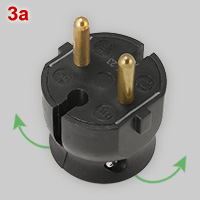 |
 |
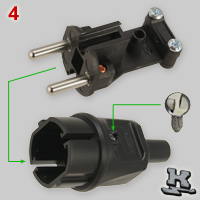 |
|
 |
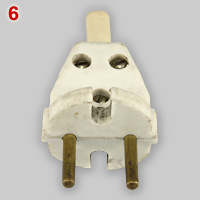 |

|
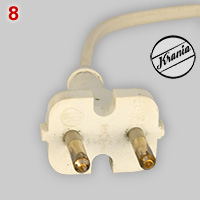 |
| 3a, b |
Asymmetrical
CEE 7/17 rewirable plug, rated at 16A - 250V. The plug, made by
Legrand, has a French (NF 61314 / UF1624) and Polish (B) certification
mark. The vertical part of the housing consists of two halves
that are connected to the basal part by flexible plastic hinges. A
single screw keeps the halves close together. Image 3b shows the
fold-out plug (upside down view compared to plug in
image 3a). |
| 4 | Symmetrical CEE 7/17
semi* rewireable plug. Rating: 16A - 250V. Plug has no VDE or other
certification mark. The synthetic rubber plug housing offers protection against ingression of water and dust according to IP44 grade. Manufacturer: Martin Kaiser in Hochstadt am Main, Germany. * semi means that the two parts of the plug are fixed with one-way screws. that cannot be removed by conventional tools because the screws can only be turned in one direction. |
| 5 | Asymmetrical,
rewireable
plug, comparable to CEE 7/17. Pins have a diameter of 4.0 mm. Thinner
pins explain a rating of 6A - 250V, rather than 16A for standard CEE
7/17 plugs that have 4.8 mm pins. Brand name EL-Bi,
Istanbul,Turkey. The company was founded in 1987 under
the name Elbistan Hirdavat (Elbistan Ironmongery). In 2013 EL-Bi became
a member of the ABB Group. The plug has a Turkish certification mark
(TSE). {WM} |
| 6 | Symmetrical,
rewirable
plug, rated at 6A - 250V. The rating of only 6A allows the use of
thinner (4.0 mm) pins The plug has 4.0 mm pins. Brand name unknown; possibly a Polish plug. {WM} |
| 7 | Plug that can be regarded as a precursor
of CEE 7/17.
The not earthed plug fits in CEE 7/3 sockets, but not in CEE 7/5. Rating: 6A - 250V; pins are partially split and have a diameter of 4 mm. The plugs is not rewirable. It has the same look as 1950s-60s Bakelite 2-pin plugs (see classic continental European plugs for examples), but the round base plate has the outline of Schuko plugs. The plug has been made of a red melamine resin. It has no certification marks and no indication of the manufacturer. {RH |
| 8 |
Two-pin,
10A plug
that fits in Schuko and French
sockets. The plug was used in former Eastern Germany (DDR) and dates
back to the 1970s-80s. It had the same functionality as nowadays
non-polarized CEE 7/17 plugs (see no. 1). This type of plug was often used for export products. It has certification marks for Western European countries, as VDE (Germany), KEMA (Netherlands) and Scandinavian countries (D, S, FI). A DDR quality mark that was typical for home market products is missing. Brand name: Krania; now: Krania Kabel-Stecker GmbH, Kranichfeld, Thuringia, Germany. {WM} |
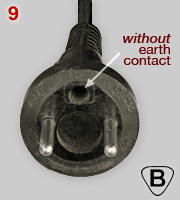 |
 |
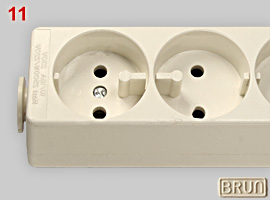 |
| 9 | Not earthed plug,
moulded to a flex cord. It has 4.0mm pins and is rated at 10A-250V.
The hole to
accommodate the socket earth pin does not have an earth contact. The
plug has a Polish, 'B' certification mark. Manufacturer: Ospel (indicated by former Polish code A-22). Dating: ca. 1960s. {WM} |
| The
CEE 7/17 standard does not include sockets and connector plugs, but
they do
exist, usually as part of an extension lead. They are incompatible with
earthed CEE 7/4 and 7/6 plugs. |
|
| 10 | Connector
plug of an extension cord, compatible only with CEE 7/17 plugs or CEE
7/16 Europlugs. The two protuberances, indicated by green arrows, block
CEE 7/4 and 7/6 plugs, but also not earthed 16A CEE 7/2 plugs that have
a round base plate (for example plug no. 9). Manufacturer: Ningbo Kaifeng Electrical Appliances Co., China. |
| 11 | Part
of a multi-outlet extension socket. It has features comparable
connector
no. 9 The socket has been made in France by an unknown company named
BRUN. {WM} |
| Compatibility of CEE 7/7 and CEE 7/17 plugs in Europe |
| A large majority of Europeans are able to
use CEE 7/7 as earthed plug and CEE 7/17 as non-earthed plug; see map
below. CEE 7/7 and CEE 7/17 have the potential to become the standard continental European plugs (Switzerland excluded). However, it can only be an effective standard when restrictions on selling rewireable CEE 7/7 and CEE 7/17 (preferably the asymmetrical variant) are lifted. Up to now in some European countries rewireable CEE 7/17 plugs are not yet allowed. Note that 2.5A non-earthed Europlugs (CEE 7/16) are already accepted in each of the continental European countries. Click here for another, more detailed map and table that show which of worldwide used domestic plugs can be used throughout Europe. |
 |
 |
Countries that have chosen for either the CEE 7/3-4 or 7/5-6 standard and thus accept CEE 7/7 and CEE 7/17 plugs. In Eastern Europe you may find unearthed sockets that only accept plugs with 4.0 mm pins (former 6A-10A Soviet standard), rather than nowadays 4.8 mm pins for 16A plugs. |
 |
In Italy some new houses, businesses
and hotels are now equipped with universal sockets that
both accept Italian, and CEE 7/7 (with functional earthing) and CEE
7/17 plugs. Italian CEI 23-50 10A and 16A sockets do not accept CEE 7/7 and CEE 7/17 plugs. |
|
 |
In Denmark DS Afsnit 107-2-D1 is the dominant standard. Danish sockets accept CEE 7/17 plugs. When CEE 7/7 plugs are used there is no earth connection. However, from 2008 CEE 7/5 sockets are allowed. CEE 7/3 sockets are allowed from 2011, but both types are not yet common. | |
 |
United Kingdom and Ireland have their own BS 1363 standard, which is incompatible with CEE 7/7 and CEE 7/17. An adapter is also needed to use CEE 7/16 (Europlugs). | |
 |
Switzerland has an unique standard, which is incompatible with CEE 7/7 and CEE 7/17. Also Liechtenstein has adopted the Swiss standard. Swiss sockets do accept Europlugs. |